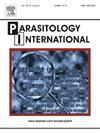Seroprevalence and associated risk factors for Fasciola hepatica in sheep in Nile Delta of Egypt
IF 1.5
4区 医学
Q3 PARASITOLOGY
引用次数: 0
Abstract
Fascioliasis is a globally distributed zoonotic parasitic disease that affects ruminants, including sheep. This study conducted from January to December 2023, aimed to determine the prevalence of Fasciola hepatica in sheep across three governorates in Egypt's Nile Delta and to assess associated risk factors. A total of 455 serum samples were analyzed using a commercial ELISA kit, revealing antibodies against F. hepatica in 22.2 % of the tested sheep. There was no significant association between locality or sex and the seroprevalence of F. hepatica in sheep; however, the highest prevalence was observed in Kafr ElSheikh and in female sheep.
Concerning risk factors, poor conditioned sheep aged between 1 and 2 years showed 2.1 and 3.8 times higher of infection probability than others. In addition, the risk of F. hepatica infection in sheep increased significantly in winter season (OR = 6.6, 95 %CI: 2.6–16.8), in absence of prophylactic treatment (OR = 2.2, 95 %CI: 1.3–3.3) and in presence of snail (OR = 3, 95 %CI: 3–5.4). The existence of antibodies against F. hepatica in examined sheep raising in Nile Delta indicating that the disease is reported in the studied areas and needs to be managed on farms through control and preventative measures.
埃及尼罗河三角洲绵羊肝吸虫血清流行率及相关风险因素。
法氏囊病是一种遍布全球的人畜共患寄生虫病,主要影响包括绵羊在内的反刍动物。这项研究于 2023 年 1 月至 12 月进行,旨在确定埃及尼罗河三角洲三省绵羊的肝包虫病发病率,并评估相关风险因素。使用商用酶联免疫吸附试剂盒对455份血清样本进行了分析,结果显示22.2%的受测绵羊体内存在肝包虫病抗体。地区或性别与绵羊的肝包虫血清流行率之间没有明显的关联;但是,在卡夫尔谢赫(Kafr ElSheikh)观察到雌性绵羊的肝包虫流行率最高。在风险因素方面,1 至 2 岁体质较差的绵羊的感染几率分别是其他绵羊的 2.1 倍和 3.8 倍。此外,在冬季(OR = 6.6,95 %CI:2.6-16.8)、未进行预防性治疗(OR = 2.2,95 %CI:1.3-3.3)和有蜗牛(OR = 3,95 %CI:3-5.4)的情况下,羊感染肝吸虫的风险显著增加。尼罗河三角洲地区受检绵羊体内存在肝吸虫抗体,这表明研究地区存在肝吸虫病,需要通过控制和预防措施对农场进行管理。
本文章由计算机程序翻译,如有差异,请以英文原文为准。
求助全文
约1分钟内获得全文
求助全文
来源期刊

Parasitology International
医学-寄生虫学
CiteScore
4.00
自引率
10.50%
发文量
140
审稿时长
61 days
期刊介绍:
Parasitology International provides a medium for rapid, carefully reviewed publications in the field of human and animal parasitology. Original papers, rapid communications, and original case reports from all geographical areas and covering all parasitological disciplines, including structure, immunology, cell biology, biochemistry, molecular biology, and systematics, may be submitted. Reviews on recent developments are invited regularly, but suggestions in this respect are welcome. Letters to the Editor commenting on any aspect of the Journal are also welcome.
 求助内容:
求助内容: 应助结果提醒方式:
应助结果提醒方式:


